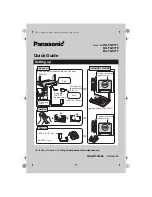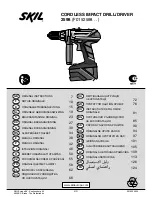
10
11
Selecting the Speed Range
The speed control dial controls the maximum
strokes per minute. The speed will remain
variable to the chosen dial setting by use
of the trigger switch. Refer to the chart for
recommended dial settings.
SUGGESTED
DIAL SETTINGS*
2-3
5
5
1-3
4-5
1-3
1-3
2-3
2-3
MATERIAL
Mild Steel
Wood
Nail-Embedded Wood
Stainless Steel
Drywall
Fiberglass
Plastics
Cast Iron
Non-Ferrous
Metals
* These are only suggested settings; the
actual optimal setting may vary depend-
ing on line voltage, blade selected and
user preference.
Trigger Speed Control Switch
These Sawzalls
®
are equipped with a trigger
speed control switch. It may be operated at
any speed from zero strokes per minute to
full speed. Always start tool before blade
contacts the workpiece. To vary the speed,
simply increase or decrease the pressure on
the trigger. The further the trigger is pulled,
the greater the speed. To stop the tool, re-
lease the trigger and allow the tool to stop
completely before removing from a partial
cut or before laying the tool down.
General Cutting
For straight or contour cutting from an edge,
line the blade up with your cutting line. Before
the blade contacts the workpiece, grasp the
handle fi rmly and pull the trigger. Then guide
the tool along your cutting line. Always hold
the shoe fl at against the workpiece to avoid
excessive vibration.
1. Insert the blade into the tool.
If you inserted the blade with the teeth
facing downward, hold the tool as shown
in Column A, resting the edge of the
shoe on the workpiece.
If you inserted the blade with the teeth
facing upward, hold the tool as shown in
Column B, resting the edge of the shoe
on the workpiece as shown.
2.
With the blade just above the workpiece,
pull the trigger. Using the edge of the
shoe as a pivot, lower the blade into the
workpiece as shown.
3. As the blade starts cutting, raise the
handle of the tool slowly until the shoe
rests firmly on the workpiece. Then
guide the tool along your cutting line to
acquire the desired cut.
NOTE:
To make plunge cutting easier,
use a heavy gauge blade and install the
blade with the teeth facing upward as
shown in Column B.
WARNING
To reduce the risk of explosion,
electric shock and property dam-
age, always check the work area
for hidden gas pipes, electri-
cal wires or water pipes when
making blind or plunge cuts.
Cat. No. 6520-21
and 6536-21
Fig. 8
Cat. No. 6523-21
Fig. 7
Cutting Metals
Begin cutting at a slow speed, gradually in-
creasing speed as you cut. When cutting into
metals or hard materials that can not be cut
from an edge, drill a starting hole larger than
the widest part of the blade. Extend blade life
by using a solid blade cutting lubricant.
Plunge Cutting
Your
MILWAUKEE
Sawzall
®
is ideal for
plunge cutting directly into surfaces that
can not be cut from an edge, such as walls
or fl oors. Orbital action is recommended for
plunge cutting. Plunge cutting may be done
two ways depending on how the blade is
inserted. Column A shows how to plunge
cut with the teeth of the blade facing down.
Column B shows how to plunge cut with the
teeth of the blade facing up.
NOTE:
Orbital action will not operate if the
blade is installed upside down.
Do not plunge cut into metal surfaces (see
“Cutting Metals”).
Maintaining Tools
Keep your tool in good repair by adopting a
regular maintenance program. Before use,
examine the general condition of your tool.
Inspect guards, switches, tool cord set and
extension cord for damage. Check for loose
screws, misalignment, binding of moving
parts, improper mounting, broken parts and
any other condition that may affect its safe
operation. If abnormal noise or vibration oc-
curs, turn the tool off immediately and have
the problem corrected before further use.
Do not use a damaged tool. Tag damaged
tools “DO NOT USE” until repaired (see
“Repairs”).
Under normal conditions, relubrication is not
necessary until the motor brushes need to
be replaced. After six months to one year,
depending on use, return your tool to the
nearest
MILWAUKEE
service facility for the
following:
• Lubrication
•
Brush inspection and replacement
•
Mechanical inspection and cleaning
(gears, spindles, bearings, housing,
etc.)
•
Electrical inspection (switch, cord,
armature, etc.)
•
Testing to assure proper mechanical and
electrical operation
WARNING
To reduce the risk of injury, always un-
plug your tool before performing any
maintenance. Never disassemble the
tool or try to do any rewiring on the
tool's electrical system. Contact a
MILWAUKEE service facility for ALL
repairs.
MAINTENANCE







































